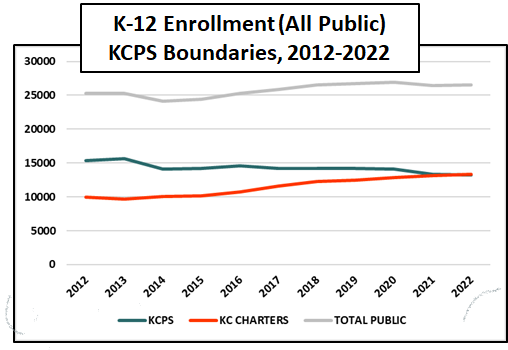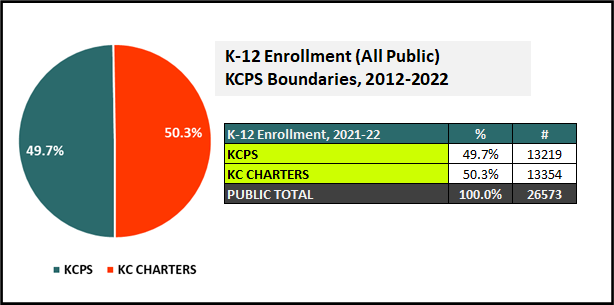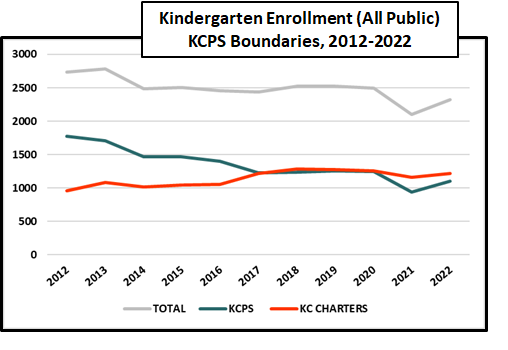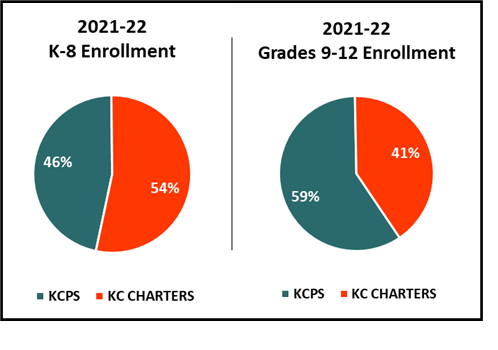Happy New Year, readers! It’s 2022 and there’s a lot to catch up on.
Accreditation’s the word
After a decade of being unaccredited or provisionally accredited, KCPS earned back full accreditation earlier this month. In making its decision, the Missouri State Board of Education cited the district’s progress in improving attendance, graduation rates, and academic growth. Stability was another contributing factor – with six years at the helm of the district, Superintendent Bedell is now the longest-serving KCPS superintendent in more than 50 (!) years. The district’s progress – and the leadership that’s enabled it – is a huge accomplishment for KCPS and a win for Kansas City.
But what Dr. Bedell said following the decision was as important as the decision itself:
“This is only the beginning…we can’t stay accredited on the path that we’re on right now. We’re antiquated, we’re outdated, we’re too rigid. And if covid didn’t teach us anything, here’s what it did teach us: that we’re not agile enough to really truly prepare these kids for the future they deserve. That means we have to dismantle this system, we have to redesign it…”
KCPS Superintendent Mark Bedell, January 11, 2022
His words were a good reminder for me of Set the Schools Free‘s central premise, and the reasons I started crunching data and developing this platform back in 2016. These were: 1) my abiding belief in traditional public education (and my concern that, as KCPS enrollment continues to decline, we’re in danger of losing something important); and 2) the powerful idea that decisions affecting students should be made in schools, closer to students.
Agile: 1) Able to move quickly and easily; 2) relating to or denoting a method of project management that is characterized by the division of tasks into short phases of work and frequent reassessment and adaptation of plans.
Making decisions closer to kids is, of course, a hallmark of charter public schools. And a lot of people don’t like charter schools! But regardless of how you may feel about charters (which are public schools that operate independently of school districts) there’s something we can learn from them.
Because the flexibility charters enjoy in decisionmaking – their ability to make decisions at the school-level, closest to kids – is key to their agility, and is one of the most important operational advantages they have over traditional public schools (where decisions, in contrast, are often made centrally, to maximize system-wide efficiencies).
If you’re interested in exploring this idea more, I’ve written about it here, here, here and here.
But accreditation aside, enrollment numbers reflect the real choices families are making. That why Set the Schools Free is kind of obsessed with them – and is so committed to sharing them with you!
Enrollment reflects real choices
Which brings us to K-12 enrollment, and the recently released 2021-22 enrollment data. Here are the big headlines:

Public School is back in session. Well, kind of. After a covid-related dip in 2020-21, overall 2022 K-12 enrollment bounced back slightly, driven by growth in charter enrollment
KCPS enrollment decreased by 7% over the last three years. KCPS K-12 enrollment decreased from 14,253 in 2019 to 13,219 in 2022. The biggest drop, in 2020 (+700 students), was pandemic-related, with Kindergarten experiencing the greatest decline (-306 students).
And charter public enrollment grew by 7% during this same period. Enrollment in charter public schools grew by 7%: from 12,435 to 13,354 between 2019 and 2022. Overall, charter enrollment has actually grown for the last nine consecutive years (even with the closure of six charter schools during this period). Enrollment growth in the charter sector has been the main driver behind growth in overall public school enrollment (overall K-12 enrollment has grown by 5% since 2012).

As a result, we’ve now hit the K-12 tipping point. We were essentially at 50-50 enrollment last year. But for the very first time this year there are, collectively, more K-12 students enrolled in charter public schools than in KCPS schools.
(Note: KCPS continues to be the biggest operator of public schools within our district boundaries. The second largest operator, Frontier Charter Schools, serves 1,556 students, followed by Guadalupe Centers (1,395) and then Academie Lafayette (1,244 students).

The Kindergarten enrollment gap has widened. Kindergarten enrollment is a leading indicator for our system of schools overall. We hit the K tipping point back in 2018 (something I originally wrote about in one of my first posts on Set the Schools Free). This gap widened during the pandemic.

And finally, charter schools now dominate K-8 enrollment. KCPS continues to make up the majority of Grades 9-12 enrollment.

Put another way:

To see how enrollment by grade segment has changed over the last few years, see 2017-18 Enrollment, KCPS Boundaries.
So, who cares?
Why should we care about enrollment? I really can’t say it enough: enrollment numbers reflect the real choices parents and caregivers make about public schools within KCPS boundaries – not the choices we might want them to make.
KCPS is now accredited, and that deserves celebration. But as of this school year, the reality within our district boundaries is that families of more than half of all K-12 students have chosen charter public schools to educate their kids. These charter schools are underfunded compared to their KCPS counterparts and, in the eyes of many, lack the legitimacy we give to traditional public schools – regardless of how they might perform.
This “outdated, rigid” thinking isn’t fair to charter school students or teachers. It also holds us back in our ability to learn from what works and to evolve our thinking. But most importantly, it holds us back in designing a more equitable, transparent, and accountable system that serves all students well.
Coming soon (hopefully): An updated 2021-22 KC Public Enrollment Dashboard, along with a dive into some demographic data.